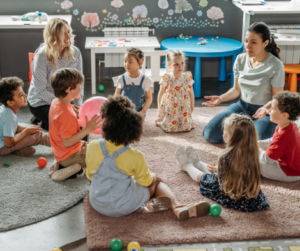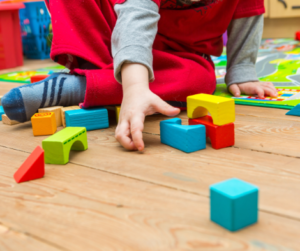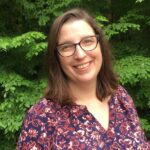Developmentally appropriate education is when a curriculum is designed to match what children are biologically—physically, mentally, and emotionally—ready to learn. It is an education that meets children where they are, gives them plenty of play opportunities, and helps them grow and develop. This form of education is so rare in America today, that you may have never seen it.
Identifying the Problem
 Modern American education asks children to start learning letters as young as three years old. This is not developmentally appropriate. Physically, children at that age do not typically have the finger coordination yet to hold a pencil and write a letter. In terms of brain development, they do not have the eye-brain connections needed for reading. And, intellectually, understanding what a letter is—a symbol representing a sound—is an abstract concept. Children at three years old are typically not ready to understand this kind of symbolism.
Modern American education asks children to start learning letters as young as three years old. This is not developmentally appropriate. Physically, children at that age do not typically have the finger coordination yet to hold a pencil and write a letter. In terms of brain development, they do not have the eye-brain connections needed for reading. And, intellectually, understanding what a letter is—a symbol representing a sound—is an abstract concept. Children at three years old are typically not ready to understand this kind of symbolism.
Over the years, as part of many different efforts to improve education in the United States, academics such as reading and writing have been pushed on younger and younger children. What was once seen as work for first graders is now being taught to four-year-olds. All in the hopes of giving children a boost. But research shows that this is going to do the opposite for our children.
Children engaged in play-based education in preschool and kindergarten, ages 3-7, outperform children in both academic programs and those in programs that combine play and academics, by third grade. And those kids keep that lead into adulthood.
How Play-Based Education is Different
 A developmentally appropriate kindergarten, or play-based kindergarten, is not just leaving your kids to play all they want. This type of program requires adults to interact with kids and help them learn a variety of educational skills, while also providing the right kinds of play opportunities.
A developmentally appropriate kindergarten, or play-based kindergarten, is not just leaving your kids to play all they want. This type of program requires adults to interact with kids and help them learn a variety of educational skills, while also providing the right kinds of play opportunities.
Adults read to the children and tell them stories. This helps the children build a more extensive vocabulary, and learn how to relate to their world. Children’s books can teach kids about science, social studies, history, and social skills. Research shows that kids need as many as 1,000 hours of lap reading before they will be ready to read for themselves. This activity is critical to building literacy skills.
Teaching children to recite nursery rhymes and sing songs builds their language skills, vocabulary, and self-esteem. Reciting songs and rhymes is our introduction to poetry, rhythm, rhyme, and public speaking. All these skills are ones children will tap into later in life. But if we skip these steps, kids don’t have other means of getting them and struggle.
Adults also provide children with opportunities to draw, paint, color, and craft. These activities help children develop the fine motor skills needed for writing and doing other complex tasks later. A child of 3, 4, or 5, might not yet have a mature grasp of a crayon or pencil, but while doing art, they can work on developing their grasp, until they find a good, mature one they can use. If you introduce writing letters at this point, the child can latch onto their immature grasp as the “right way to write” and not be able to make the change to a better pencil grasp. Being pushed to write too young, instead of doing these crafts and art skills, is leading to a lot of children with poor handwriting.
Building Life Skills
 In addition to storytime and art, developmentally appropriate kindergartens engage the children in the work of running the class. Children help make the class snack, tend the garden, and help clean up between activities. These tasks teach children life skills. When children learn life skills early, they become happier and more confident. Seeing themselves as competent to do these tasks prepares children to take on more complex tasks in academics later.
In addition to storytime and art, developmentally appropriate kindergartens engage the children in the work of running the class. Children help make the class snack, tend the garden, and help clean up between activities. These tasks teach children life skills. When children learn life skills early, they become happier and more confident. Seeing themselves as competent to do these tasks prepares children to take on more complex tasks in academics later.
The children also learn a variety of games that help them learn to follow directions, do complex tasks, take turns, and learn to use their bodies better. Games like “Red Light, Green Light” are great examples of how kids can learn to control their bodies.
Children need time to develop mature forms of play with peers using a variety of toys. Mature play at age 5 means that children can work together, pretend to have roles and create complex games that multiple children participate in. This is the foundation for getting along with peers for the rest of our lives. As adults, we have to collaborate with our co-workers, compromise with our life partners, and know how to work with others towards common goals. Toys like dolls, dress-up clothes, blocks, trains, puppets, and balls, all provide for a variety of play that develops social skills in a wide variety of ways.
Academically-focused kindergarten programs lack time for imaginative and engaging play. Instead, they use that time to push children to do things they aren’t ready to do, skipping over key developmental activities. They also tend to separate kids by age, which means that older kids don’t have the opportunity to teach younger children skills through play. Mixed-aged classrooms offer children opportunities to learn from their more experienced peers and, for the older child, to be a mentor.
Making Room for Children with Special Needs
 Children with special needs often need this style of education as much if not more than their peers. Today, more children than ever are being labeled with a learning disability. I have worked with many children in my occupational therapy work who have special needs. The thing is, what I’m paid to do with those kids is largely things that they would have gotten in a good play-based program. I set up crafts, games, and challenges to help them “catch up”. But, in truth, many would not need to see me or would need me less if they had had a few years of play-based, developmentally appropriate education instead of being pushed into academics too soon.
Children with special needs often need this style of education as much if not more than their peers. Today, more children than ever are being labeled with a learning disability. I have worked with many children in my occupational therapy work who have special needs. The thing is, what I’m paid to do with those kids is largely things that they would have gotten in a good play-based program. I set up crafts, games, and challenges to help them “catch up”. But, in truth, many would not need to see me or would need me less if they had had a few years of play-based, developmentally appropriate education instead of being pushed into academics too soon.
That isn’t to say that a developmentally appropriate kindergarten can “cure” or prevent a learning disability. But kids get labeled “behind” in preschool, and that label can be hard if not impossible to lose. However, if we gave these children more time in a play-based environment before introducing academics and taught developmentally appropriate skills, they could excel. There is no good reason to push them to do all these academic skills before they are ready. The child who learns to read at 8, will read just as well as the child who starts learning at 5.
And gifted kids, what about them?
Would it “hold gifted children back” to give them a developmentally appropriate education? Not at all. The thing to understand about gifted kids is that they want to learn. And they will take lessons further and deeper than most kids. But that doesn’t mean you have to do academic skills. And if you do start academic skills early, they are just as at risk for missing out on developmentally necessary skills as any other child.
The gifted child needs opportunities to learn, create, and play. Their block towers will be more complex and take longer to build, but they will still benefit from making them. Their doll play may involve acting out more interesting or unusual things with their dolls, but they still get social skills. Their desire to listen to several books instead of just one feeds their desire to learn about the world.
None of this means we need to push them to learn to read and write sooner, even if some of them figure it out for themselves. Gifted kids are just as much at risk as other kids for missing out on learning social skills, life skills, and motor skills if we push them ahead. Gifted kids often need help to develop at least one of those skills. So giving them more time to play will serve them better in life.
What can we do?
 While I do hope that the public school system works to return to a developmentally appropriate education method, I know it will take time. Public schools are going to continue to struggle to make changes that require approval from local school boards and depend on funding that requires test scores.
While I do hope that the public school system works to return to a developmentally appropriate education method, I know it will take time. Public schools are going to continue to struggle to make changes that require approval from local school boards and depend on funding that requires test scores.
As homeschoolers, we can choose to step away from these dysfunctional trends. Instead of stressing about test scores and Lexile levels, we can choose to give our children developmentally appropriate educations that prepare them for life. We can choose to teach letters and numbers a little later when children are ready. We can instead focus on helping our children gain the skills they will need to be successful for many years to come while delaying academic skills the child isn’t quite ready to do yet.
When we reject the laundry list of skills the schools have pushed down onto children from ages 3-7 and instead help our children learn about the world and develop their skills and sense of self, we set them up for success.
P. S. I have read a lot of different research articles and reports on education, in particular kindergarten. Here are links to a few articles that I found most interesting and referenced in my conclusions above. If you are interested in reading more about the importance of taking child development into account in education, I recommend these articles.
Crisis in the Kindergarten, a report for the US Department of Education
Psychology Today Article on the long-term harm of early Academics.


 Laura Sowdon, OTR/L is an occupational therapist, writer, speaker, educator, and creator of the Five Senses Literature Lessons homeschool curriculum. She has worked as an occupational therapist with children in public and private schools, as well as private practice. Laura has taught and managed homeschool co-ops as well as homeschooling her own three children. Laura is dedicated to the idea of educating children at a pace that aligns with brain and physical development milestones and respects neurodiversity in all its forms.
Laura Sowdon, OTR/L is an occupational therapist, writer, speaker, educator, and creator of the Five Senses Literature Lessons homeschool curriculum. She has worked as an occupational therapist with children in public and private schools, as well as private practice. Laura has taught and managed homeschool co-ops as well as homeschooling her own three children. Laura is dedicated to the idea of educating children at a pace that aligns with brain and physical development milestones and respects neurodiversity in all its forms.


